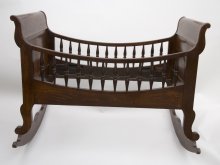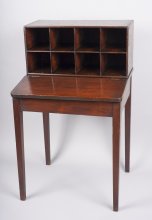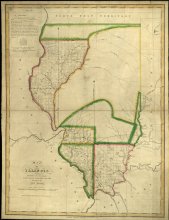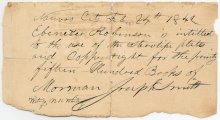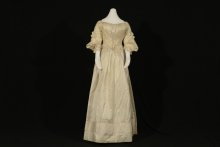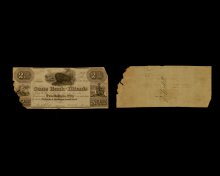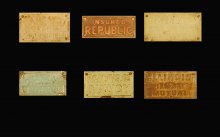Early Statehood (1818-1848)
On December 3, 1818, Illinois became the twenty-first state of the Union. Ostensibly a free state, slavery was “grandfathered” in to the constitution for existing colonial slaveholders, and all citizens were permitted to keep indentured servants. Over the next thirty years, the state experienced a transition from an American frontier to a settled and rapidly developing agricultural state. Technology changed agriculture and expanded markets. It also fostered changes in government, legal, and educational institutions.
In 1832, Black Sparrow Hawk, a Sauk warrior, and more than 1,000 Sauk and Fox, attempted to return to their principal community of Saukenuk, present-day Rock Island. Conflict soon followed, and warriors fought a series of battles with Federal troops and Illinois militia in Illinois and Wisconsin. Decimated in a final fight at Bad Axe in Wisconsin, the Sauk and Fox, along with other tribes once resident in Illinois, signed a treaty reaffirming their land cessions and moved to reservations west of the Mississippi River.
The Lincolns were fortunate to have a long back porch on their house when they purchased it in 1844. Despite adding on and changing the house elsewhere, they kept the south-facing porch as long as they lived in the house, only adding some latticework in one section for shade and a place for the climbing roses to grow, making it a pleasant place to pass the time.
Highs and lows were captured in this one artifact from the Lincolns’ lives in Illinois. The Lincolns’ oldest son, Robert, was born while they were living in one room at the Globe Tavern, and this cradle would have been much too large and expensive for the Lincolns. After the family moved into their one and a half story home, and Mary had their second son, Eddie, in 1846, they had the room and a little extra money to purchase this large walnut cradle.
Abraham Lincoln used this desk when he first “began to do business for myself” around 1844, according to the affidavit. About ten years later, he brought it home to his new second floor bedroom and used it there for a few years until he upset the inkwell on it and upset Mrs. Lincoln in the process. She threw it out!
There are only four surviving copies of this 1818 map of Illinois, which was printed in Philadelphia. John Melish produced it from surveys in the General Land Office and a few other sources. Produced only a few months before Illinois achieved statehood, the map reflects the priorities of early settlement, highlighting military bounty lands granted to War of 1812 veterans in color.
This note was written by the founder of the Church of Jesus Christ of Latter Day Saints (Mormon Church), Joseph Smith, during his time in Nauvoo, Illinois.
Much of what we know about the Kickapoo Indian Tribe in Illinois comes from an archaeological investigation that took place prior to a road-building project in the 1970s. This copper or brass kettle was one of the artifacts uncovered from the Rhoads village site. Excavations revealed a mix of traditional stone tools, arrow points, pottery, and other objects mixed with items of European origin including glass beads, silver crosses and jewelry, ceremonial smoking pipes, and this kettle.
Sixteen-year-old Catherine Geers wore this dress when she married a young lawyer named Richard Yates in Jacksonville on July 9, 1839. The couple had five children, though one died in infancy, and one was struck by lightning and killed at age 11.
Private Patrick Carroll carried this musket during the Civil War when he served in the 32nd Illinois Infantry Regiment. Carroll, a native of Ireland, was a 26-year-old blacksmith when he mustered into service at Camp Butler on December 31, 1861. He saw action at the battle of Shiloh and the siege of Corinth before being discharged for disability in August 1862. He returned home to Fayette County, married, fathered seven children, and died in 1901 at age 66.
This scrip was used to help fund one of Illinois’ earliest and most significant infrastructure projects, the Illinois and Michigan Canal, which joins the Chicago and Illinois Rivers and ultimately connects the Great Lakes to the Mississippi River.
These metal plates were recovered from the facades of pre-Civil War structures throughout Illinois. They were issued by fire insurance companies as a way for policy holders to publicly indicate that their buildings and possessions were insured against loss by fire.
Pages







